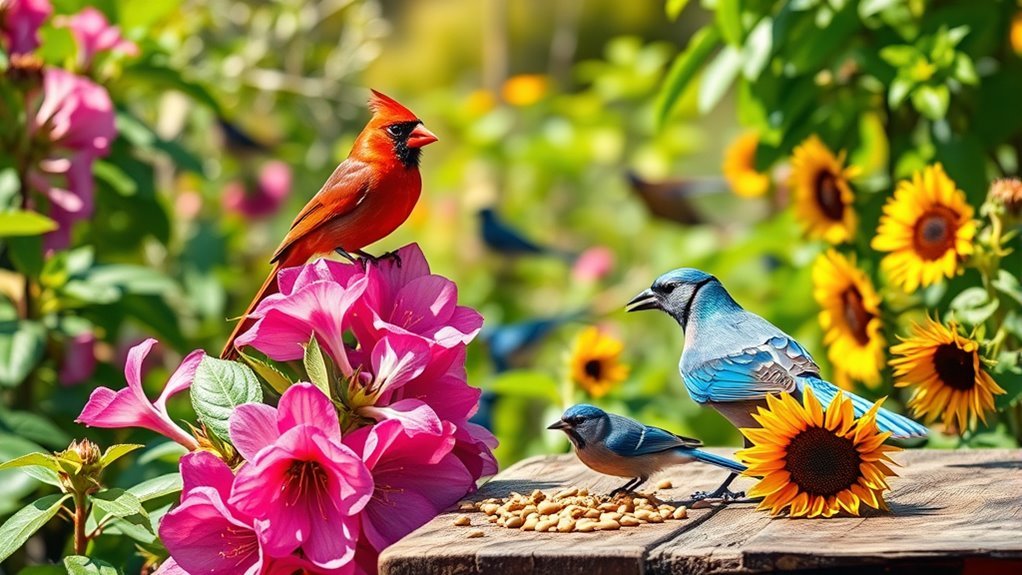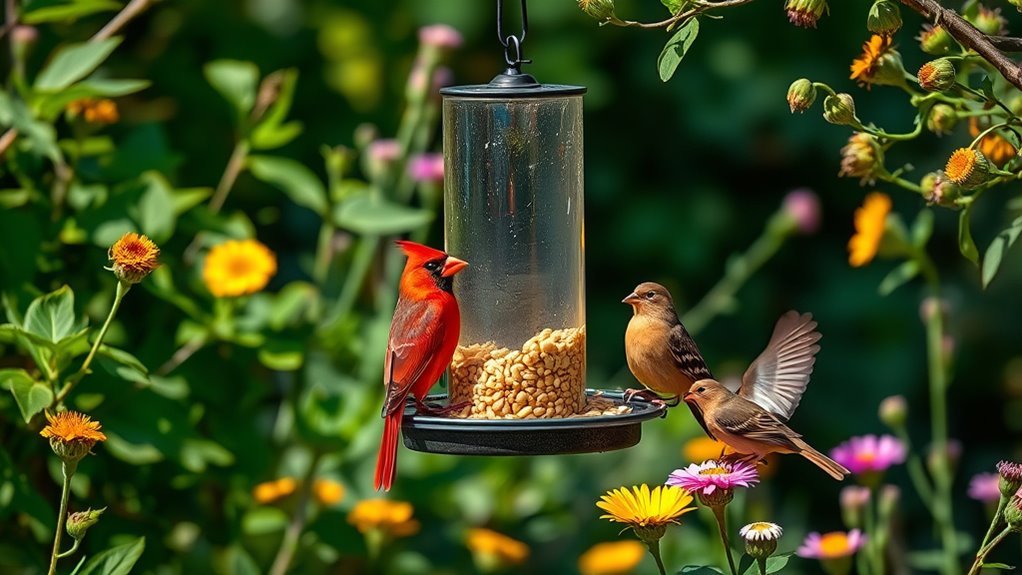Backyard Birds in Georgia
In Georgia, backyard birds show the state's rich environments. Each bird, like the bright American Goldfinch and clever Blue Jay, has unique traits and habits. Knowing these traits can improve your birdwatching experience.
To attract these birds, you need to plan carefully and learn what they like. Here are some straightforward steps to make your backyard a welcoming place for these birds:
- Provide Food: Use bird feeders filled with seeds that appeal to local species. Sunflower seeds are a popular choice.
- Offer Water: Place a birdbath in your yard. Birds need water for drinking and bathing.
- Create Shelter: Plant native shrubs and trees that offer shelter and nesting spots. Birds feel safer in natural environments.
- Minimize Chemicals: Avoid pesticides in your garden. Birds are safer and healthier without chemical exposure.
- Be Patient: Give birds time to discover your yard. It may take a while for them to feel comfortable.
By following these steps, you can create an inviting backyard that attracts a variety of birds, enhancing your birdwatching enjoyment.
Key Takeaways
- Common backyard birds in Georgia include the American Goldfinch, Northern Cardinal, Downy Woodpecker, and Blue Jay.
- Offering a variety of seeds in feeders attracts diverse bird species to your yard.
- Installing a birdbath provides essential water for birds to drink and bathe.
- Selecting native plants in your garden creates food and shelter for local bird populations year-round.
- Engaging in birdwatching fosters a deeper connection to nature and supports conservation efforts.
Overview of Georgia's Bird Diversity

Georgia isn't just known for its peach trees and hills; it's also rich in bird diversity. The state has many bird species across different habitats.
You can find unique birds, like the Brown-headed Nuthatch, in its pine forests. Georgia is an important stop for migratory birds, such as the Peregrine Falcon, along the Atlantic Flyway.
Knowing about these migration patterns helps conservation efforts and unites birdwatchers. Engaging with Georgia's birds allows you to connect with nature and a community dedicated to protecting these species and their habitats.
Common Backyard Birds in Georgia
In your backyard, you'll likely see a variety of birds that add color and life to the Georgia environment.
You may spot the American Goldfinch with its bright yellow feathers and cheerful chirps. The Northern Cardinal, known for its bold red color and sweet songs, often moves between trees.
You might also notice the Downy Woodpecker, which has a spotted back and makes pecking sounds. Blue Jays, recognized for their intelligence and unique calls, often make a strong presence in your yard.
These birds enhance Georgia's bird diversity, deepening your connection to nature right outside your door.
Attracting Birds to Your Yard

How can you make your backyard friendly for birds? Start by adding bird feeders and using native plants. These steps will help create a welcoming space for birds.
- Place bird feeders with a variety of seeds for different bird species.
- Add a birdbath to provide water for drinking and bathing.
- Choose native plants that bloom at different times, ensuring food and shelter year-round.
These actions will help bring more birds to your yard and enhance your outdoor space. Enjoy watching your feathered friends flourish!
Essential Bird Feeding Tips
To attract and feed birds in your backyard, focus on both the food and how you provide it. Choose bird food that appeals to local species, such as sunflower seeds or seed mixes.
Use suitable feeder types: tube feeders are great for small songbirds, while platform feeders work for larger birds and those that feed on the ground.
Place feeders in quiet, sheltered spots for safety and easy access.
Keep your feeders clean by regularly emptying and washing them to prevent mold and disease.
Creating Bird-Friendly Habitats

Bird feeders attract many birds, but creating bird-friendly habitats includes more than just food.
To support different bird species, add native plants and water features to your space. Native plants offer food and shelter that meet the needs of local birds. Water features, like birdbaths or small ponds, help birds stay hydrated and clean, making your habitat more appealing.
Here are some simple ways to get started:
- Plant native trees and shrubs for nesting.
- Design layered gardens with varying heights and textures.
- Add a water feature that circulates water to keep it fresh.
Birdwatching Essentials
To enjoy birdwatching, gather essential gear to enhance your experience.
Start with quality binoculars. Choose binoculars with at least 8x magnification for clear viewing. Adjust the diopter for better clarity. Use a comfortable neck strap to avoid fatigue during long periods of observation.
Next, get a solid field guide specific to Georgia's birds. This guide will help you quickly and accurately identify different species. Keeping a notebook to record your sightings and bird behaviors can also be very helpful.
Make sure to bring sunscreen and insect repellent to stay comfortable in the field.
Joining a local birdwatching group can add value to your experience. You can share knowledge with others and enjoy birdwatching together.
Seasonal Bird Migration Patterns
As seasons change in Georgia, bird migration becomes a captivating event. Birds respond to changes in temperature and daylight, which trigger their migration. Many travel long distances to reach places with more food and milder weather.
- Warblers leave Georgia for Central America by late fall.
- Hawks fly south, taking advantage of thermal currents to conserve energy.
- Shorebirds follow coastal paths, stopping at wetland areas to rest and eat.
Understanding Bird Behavior
Bird behavior reveals important details about how they survive and interact socially. Birds use vocal sounds and body movements to communicate and establish their places in the social order.
During mating seasons, many bird species show territorial behaviors. They may puff up their feathers, sing loudly, or fly in intricate patterns to claim their space. Watching these actions helps you understand their need for space and resources.
Some birds engage in cooperative feeding, where they work together to find food more effectively. Observing these behaviors enhances your appreciation for birds and their traits in Georgia's ecosystems.
Benefits of Birdwatching
Birdwatching is an enjoyable activity that offers many benefits for individuals and the environment. This practice encourages you to be present in nature, helping to reduce stress and promote relaxation.
Additionally, birdwatching connects people who share an interest in wildlife and conservation.
- It improves mental health by lowering stress levels.
- It raises awareness about biodiversity and the need for habitat protection.
- It builds friendships and connections with other birdwatchers.
Engaging in birdwatching is a rewarding way to appreciate nature while contributing to conservation efforts.
Resources for Bird Enthusiasts
Enhancing your birdwatching experience is simple. Use birding apps like Merlin Bird ID or eBird to improve your identification skills and log your sightings easily. These tools help you recognize various species and provide important information to local conservation groups.
Getting involved with these organizations through community events or volunteer work can deepen your passion for birds. Connecting with other bird enthusiasts allows you to share experiences and learn together.
You can help monitor bird populations and support local research. Using technology and engaging with your community will increase your appreciation for Georgia's diverse bird life. Enjoy your birdwatching journey!
Frequently Asked Questions
What Are the Best Times to Observe Backyard Birds in Georgia?
To effectively observe backyard birds in Georgia, focus on two key times: early mornings and late afternoons. Birds are most active in the morning, which allows you to spot them foraging for food. In the late afternoon, you can see them gathering for their evening meals. By timing your observations during these periods, you increase your chances of seeing a wide variety of bird species in action.
How Do I Identify Bird Calls and Songs in My Area?
To identify bird calls, listen carefully and note their patterns. Use apps to compare and identify songs and calls. Recording these sounds helps you improve your skills and connects you with local birds better.
Are There Any Birds in Georgia That Are Pet-Friendly?
Yes, certain pet bird species can thrive in friendly environments. Canaries and budgerigars do well in spaces with plenty of plants and safe places to rest. Creating a welcoming area is important for their health and builds a strong bond between you and your pets.
What Should I Do if I Find an Injured Bird?
If you find an injured bird, take these steps:
- Contact Help: Call local wildlife rehabilitation resources for assistance. Follow local laws regarding wildlife.
- Assess the Bird: Look at the bird's condition carefully. Avoid touching it unless necessary.
- Create a Safe Space: Keep the bird in a quiet area away from pets and people. This helps reduce stress until help arrives.
Can I Report Bird Sightings to Local Wildlife Organizations?
Yes, you can report bird sightings to local wildlife organizations. You can use birdwatching apps to document your sightings easily. Joining local birding clubs allows you to share your findings and meet other birdwatching enthusiasts. This helps in promoting conservation efforts in your area.

Hello, I’m Amelia White, the founder of birdsfanatic.com. As a lifelong bird enthusiast and spiritual seeker, I’ve always been fascinated by the mystical connections between birds and the human experience. On this site, I share my knowledge and insights into the symbolic meanings and spiritual significance of various bird species, exploring their roles in mythology, folklore, and cultural traditions. Join me on this journey into the world of birds, where we’ll discover the hidden wisdom and guidance that these magnificent creatures have to offer.







